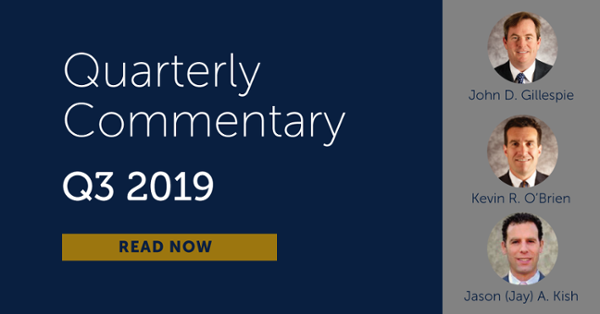“After a ten-year post-financial crisis period of consistent underlying conditions for equity investing, fundamentals are shifting.”
Since the Federal Reserve (Fed) began employing its accommodative monetary policies, it has fueled a leveraging cycle and we believe it’s a virtual certainty that we will go through a credit/deleveraging cycle of some form in the future. While we have little ability in predicting the cycle, we continue to focus on things we can control, such as evaluating corporate balance sheets with scrutiny. We believe that at this point, it is of the upmost importance to invest in companies with conservative balance sheets that should exhibit resilience through a credit/economic cycle while exhibiting attractive earnings growth in the current environment.
Additionally, and specifically related to the overnight funding situation (the repo market recently exhibited a level of instability not seen since the financial crisis, requiring intervention from the Fed), we are favoring smaller, high-quality banks. Specifically, we tend to favor banks which hold significant excess capital, have “vanilla” balance sheets, a low dependency on overnight borrowings, and small enough to be exempt from onerous regulatory requirements. While not immune, we expect these types of companies to be more resilient to any potential stress in the money markets. That said, we are hopeful this liquidity issue will abate over time. The Federal Reserve will let its balance sheet expand over time which will inject cash into the system, thereby improving liquidity. Furthermore, there is momentum from the Federal Reserve and OCC behind scrapping a margin requirement rule which would free up $40 billion in capital for lending activities among other proposed reforms.
Outlook
After a ten-year post-financial crisis period of consistent underlying conditions for equity investing, fundamentals are shifting. Modestly slowing economic growth and macro concerns have given investors pause and led to a rerating of certain risk assets. Regardless, the U.S. economy remains fundamentally healthy and continues to be a global leader.
Interest and mortgage rates remain near historically low levels, having retraced by over 160 basis points from the October 2018 highs as inflation remains benign and economic growth moderates. Although we are clearly late in the economic cycle, the odds of a 2020 recession without a full-blown trade war seem low.
Investment-grade corporations have decent balance sheets and are currently producing acceptable free cash flows. We are carefully monitoring aggregate corporate debt levels (especially the BBB- debt which is a single notch above junk status), which now sit above pre-2008 crisis levels. The 2018 corporate tax cuts and the ability to repatriate foreign cash holdings should continue to drive higher employment, M&A activity, and capital returns including buybacks and dividends. Profit margins remain near all-time high levels, currently 10%, and look to be at some risk from higher wages and input costs.
In our estimation, equity valuations have quickly bounced back to elevated levels. During the last four months of 2018, we moved to the seventh decile from the tenth decile on trailing operating earnings only to rebound back to the ninth decile. Equities look most reasonable when comparing earnings yields to Treasury or even high-grade corporate bond yields. We currently believe equities are a superior asset allocation alternative to bonds over the longer term.
This article in an excerpt taken from our Q3 2019 Commentary.
If you are interested in reading the commentary in full, please click below.


